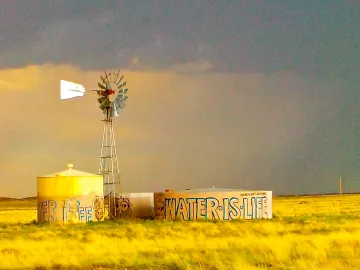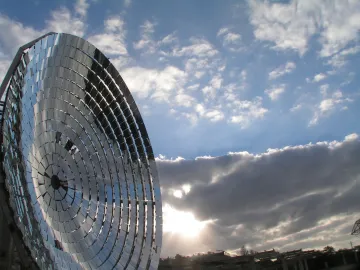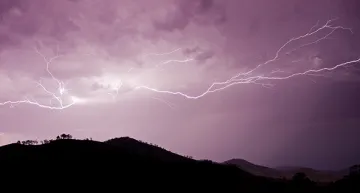Research
The Institute for Energy Solutions supports interdisciplinary and innovative research related to energy and works with other academic institutions to address the challenges and develop solutions in the energy - water - food nexus.

Arizona Energy Policy Initiative
It is important to have research-based understandings of the societal and economic impacts of innovative science and technologies, especially in relationship to under-served populations. Energy policy research being done at the University of Arizona works to support the development of unbiased policy recommendations for energy issues and outreach.
Energy and Fuel Cell Laboratory
Led by Dr. Peiwen (Perry) Li, the Energy and Fuel Cell Laboratory is funded by the U.S. Department of Energy to research and develop more affordable and efficient concentrated solar power systems. The research team includes several researchers from various engineering disciplines within the UA College of Engineering's School of Sustainable Engineered Systems, and from project partners ASU Poly and Georgia Tech. The project also involves several researchers from various engineering disciplines within the UA College of Engineering's School of Sustainable Engineered Systems, or SSES.
Lithium-Sulfur Batteries
Dr. Jeffery Pyun researches a new approach is to use waste sulfur, a byproduct of gasoline use, to make a moldable polymer, a use for which sulfur isn't ordinarily suited due to its unwillingness to form polymer chains. The creation of sulfur-based plastics with enhanced conductivity will eliminate the need for conductive carbon fillers and create Li-S batteries with 200-300% greater volumetric energy density. This advance will afford high energy density Li-S batteries that are both lightweight and more compact. This process utilizes inexpensive starting materials and can be synthesized in two synthetic steps, which are attractive features crucial for commercialization by the chemical industry.

Smart Grid Optimization
Renewable energy is complex and varied, and can often only be generated during certain times. This intricacy requires a system that can be adapted and expanded without detriment to the existing infrastructure. The research on solar energy conducted here at the University of Arizona has guided Dr. Fan’s research into a more responsive system—as solar panels become a common commodity, the demand for an update to the power grid grows. A smart grid which is constantly monitoring and automatically correcting for fluctuations in energy will minimize energy waste. The models that Dr. Neng Fan’s research team creates allows us to test the viability of the technologies still being developed as well as the economic consequences.
Solar Energy
IES solar energy research initiatives are diverse, innovative, and cross-disciplinary. Research areas include:
- AzRISE/TEP Test Yard
- CPV/CSP Hybrid Solar Energy
- Organic Thermoelectrics
- Solar Glass
- IESTE Project

Bio Fuel
Regional Algal Feedstock Testbed (RAFT)
Research at the UA for Biofuels is focused on the development of technically viable sustainable and cost effective algal feedstock production. The UA Regional Algal Feedstock Testbed (RAFT) research project is a $8 million DOE-funded project to create a long-term cultivation data necessary to understand and promote biomass production. By using outdoor testbeds, long-term algal cultivation data is gathered to develop best management practices, improve cultivation models and optimize biomass productivity using impaired waters. The project has yielded the development of real-time sensors and control strategies for efficient cultivation and culture diagnostics using molecular markers. Working with industrial, government and academic partners has advanced the algal and bio-products industry for commercialization.
Sustainable Bioeconomy for Arid Regions
With funding and support from USDA-NIFA, SBAR research focuses on guayule and guar as means to address the need for domestic bioproduct and biofuel production in the Southwest. Both plant species are suited to the climate of the arid southwest and viable options for feedstock development, feedstock production and co-products, and feasibility pathways for delivery, transport and ultimately commercialization.

Power Forecasting
The UA PFG creates high-resolution weather models and power forecasts for 2.7 GW of renewable energy power in operation with electric utility companies in the Southwest. The PFG creates forecasts in multiple time frames from sub-hourly to hourly to seven days in advance for use by electric utility wholesale energy schedulers, grid operators, day-ahead energy marketers, and real-time traders. An important aspect of these forecasts is that they present not just a single forecast number, but a range of outcomes derived from multiple runs of our customized high-resolution weather model. This provides the end user with both an idea of forecast accuracy and forecast variability and power output from variable energy resources. With these functions, users of the forecast can improves energy market trading strategies, schedule more efficient generators, reduce costs, defer maintenance and optimize use of battery storage.
